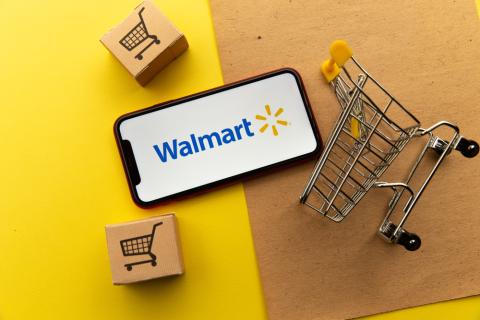How Regional Grocers Can Compete With Walmart’s Online Price Advantage

New research illustrates how much Walmart will continue to challenge regional retailers’ e-grocery business. According to grocery e-commerce solutions provider Mercatus, the low-price market leader enjoys on average a 15% price advantage online based on a large basket of groceries in the United States; it relies very little on service fees to support the cost of pickup operations; and it generates over eight times more net revenue from retail media per online order compared to some regional grocers. Mercatus says the advantages will continue to increase for Walmart in the coming years as retail media monies are projected to climb at least 20% annually while automation will lower its cost to fulfill online grocery orders even further.
These insights are part of recent research that Mercatuscommissioned analytics and strategic insight firm Brick Meets Click to conduct. The research suggests that regional grocers who operate their own e-commerce website and/or mobile app should reassess the role and relationship that various elements of pricing can have in creating a win-win outcome for customers and retailers alike.
[Read more: "Key Strategies for Retailers Facing Online Competition"]
“A key takeaway of this research initiative is that regional grocers need to consider pursuing a different path forward for online pricing because they typically have less ability to cover the incremental costs of these value-added services than Walmart,” said Sylvain Perrier, president and CEO of Toronto, Canada-based Mercatus. “We recognize that grocers may view pricing as a third-rail topic, but the rationale and evidence for adopting a new online pricing paradigm continues to strengthen, and we want to help grocers navigate how they adapt to these competitive realities.”
The new online pricing paradigm shift also better aligns with why customers choose to buy from a regional grocer and points to a more sustainable path to competing online.
Last year Mercatus found that most customers shop with a regional grocer because it is “conveniently located,” and this year Mercatus quantified what that means: Four in 10 customers who say a regional is their primary grocery store indicated that it is the closest store to home. In contrast, nearly half of those who say Walmart is their primary grocery store drive past two or more rival stores to shop at the mass discounter.
Although “conveniently located” largely relates to in-store shopping, it also applies to online shoppers who receive their orders via pickup since this requires a trip to the store. The difference between regionals and Walmart reveals the implied trade-off between cost and convenience that customers make when selecting where to shop.
[Read more: "How These Top Regionals Learned to Thrive in Any Competitive Landscape"]
Mercatus also says regional grocers have the potential to help customers save money when shopping online under the new pricing paradigm. For instance, grocers can benefit from leveraging a variable fee structure that flexes up or down based on when the customer wants to receive the online order. This approach achieves two things: First, it empowers the customer to choose whether “speed” or “fee” is more important to them relative to that specific order, and second, it creates more opportunities for the retailer to realize labor savings by batching together orders during the pick and pack operation.

Brick Meets Click developed framework for regional grocers that tackles the core challenges associated with gaining agreement, positioning, and managing the various pricing elements of this paradigm shift. The framework starts with documenting the cost to fulfill orders today, and the role of service fees and retail media monies in helping to cover or offset this value-added service. It then examines how grocers can improve efficiencies further by taking advantage of the interaction between fees and assembly activities before assessing an appropriate price premium for products online. And the waterfall chart (pictured above) illustrates where and how a regional grocer is likely only covering a portion of the direct labor cost related to fulfilling a pickup order today.
“Regional grocers are well positioned to help their customers save time, and they can also offer customers additional ways to save money based on how they want to shop,” explained David Bishop, partner at Brick Meets Click. “Strategies like having lower prices compared to third-party marketplaces, price protecting ad items, offering digital coupons, and offering graduated fees based on pickup times are all ways grocers can help their customers save money when shopping online.”
The Mercatus research consisted of two parts: an in-market pricing study and an online consumer survey. The pricing study was conducted in the Plano, Texas, trade area and encompassed eight retail banners (ALDI, Costco, H-E-B, Kroger, Market Street, Target, Tom Thumb and Walmart). It tracked a basket of 40 commonly purchased products and captured both in-store and online product prices at stores located within 5 miles of each other, using the banner’s first-party site or app and the same store as the pickup location for each respective banner. It also captured every day and promoted prices, loyalty card savings, temporary price reductions, and coupons March 15-16, and documented all related charges and fees associated with receiving a pickup order. The online consumer survey was conducted June 5-6, and collected the responses of 1,946 adults, 18 years and older, who participated in the household’s grocery shopping.







